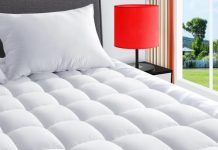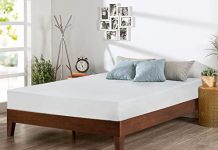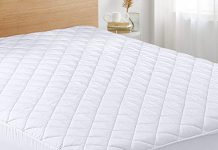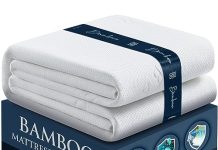Interested in using a duvet cover but questioning the need for an insert? Look no further as we explore the possibility of using duvet covers without inserts. We understand the desire for a simple and fuss-free bedding solution, so let’s uncover the truth and discover if duvet covers can indeed stand alone to provide the comfort and style you seek.
Review contents
What is a Duvet Cover?
A duvet cover is a protective covering that encases a duvet or comforter, providing both style and functionality to your bedding. It is usually made of fabric, with an opening at one end that allows you to insert and secure the duvet inside. Duvet covers come in a variety of sizes, designs, and materials, allowing you to personalize your bedroom decor and keep your duvet clean and protected.
What is a Duvet Insert?
A duvet insert, also known as a duvet or comforter, is a thick, fluffy blanket filled with down or a synthetic material. It is meant to be used as the inner layer of bedding, providing warmth and insulation during colder nights. Duvet inserts are typically larger than the size of the bed, allowing them to drape over the sides and provide a cozy, enveloping feeling when used with a duvet cover.
Pros and Cons of Using a Duvet Cover Without an Insert
1. Pros of Using a Duvet Cover Without an Insert
Using a duvet cover without an insert can offer several advantages. Firstly, it allows for easier maintenance and cleaning. Duvet covers can be easily removed and laundered, keeping your bedding fresh and hygienic. Additionally, without an insert, you can achieve a lighter and more breathable sleep experience, perfect for warmer climates or those who prefer a cooler sleeping environment. Lastly, using a duvet cover alone allows for greater versatility in terms of design options and the ability to change your bedroom decor more frequently.
2. Cons of Using a Duvet Cover Without an Insert
However, there are a few drawbacks to using a duvet cover without an insert. One of the main disadvantages is the lack of insulation and warmth provided by a duvet insert. Without the extra layer of padding, you may find yourself needing additional blankets or layers to keep warm during colder months. Additionally, without an insert, the duvet cover may not have the same plush and cozy feel as when used in conjunction with a duvet insert. This can affect the overall comfort and snugness of your bed.
How to Use a Duvet Cover Without an Insert
If you decide to use a duvet cover without an insert, there are a few key steps to follow to ensure proper use and comfort.
1. Properly Securing the Duvet Cover
To start, place your duvet cover flat on your bed with the opening at the foot of the bed. Then, insert your hands inside and grab the top corners of your duvet cover. Reach all the way to the end of the cover, gathering the duvet insert along with it. Once you have a firm grip on the corners, shake the duvet cover downwards, allowing the insert to settle inside. Finally, secure the duvet cover with buttons, ties, or a zipper, ensuring it is evenly distributed and covers the entire duvet insert.
2. Adding Layers for Comfort
Since you won’t have the extra padding of a duvet insert, consider adding additional layers for comfort. You can opt for a lightweight blanket or quilt between the fitted sheet and the duvet cover to provide some extra warmth and coziness. Alternatively, layering multiple blankets or using a thicker comforter can help achieve the desired level of warmth and comfort.
3. Maintenance and Cleaning
One of the benefits of using a duvet cover without an insert is the ease of maintenance and cleaning. Simply remove the cover from the duvet insert and launder it according to the care instructions provided. Regularly washing your duvet cover will help keep it fresh, clean, and free from allergens. Additionally, consider fluffing and airing out your duvet insert periodically to maintain its loft and remove any trapped dust or odors.
Tips for Choosing the Right Duvet Cover
When selecting a duvet cover to use without an insert, there are a few factors to consider to ensure the best fit and comfort.
1. Fabric and Material
Choose a duvet cover made of a fabric that suits your preferences and needs. Cotton is a popular choice due to its breathability and softness, while microfiber provides a silky feel and is often more affordable. Consider the thread count as well, as higher thread counts typically indicate a softer and more luxurious fabric. Additionally, consider the hypoallergenic properties and durability of the material, especially if you have allergies or pets.
2. Size and Fit
Ensure that the duvet cover you choose is the proper size for your mattress. Measure the dimensions of your mattress and select a duvet cover that matches these measurements. If you prefer a more casual and relaxed look, you can opt for a slightly oversized duvet cover. However, be mindful that a too-large cover may result in uneven distribution and discomfort during sleep.
3. Design and Style
Since the duvet cover will be the main visual element of your bedding, consider the design and style that best fits your bedroom decor. Whether you prefer solid colors, patterns, or intricate designs, there are countless options to choose from. Take into account the overall aesthetic of your bedroom and select a duvet cover that complements or enhances the existing style. Additionally, consider the ease of coordinating or changing the duvet cover with other decorative elements in your room.
Alternatives to Using a Duvet Cover Without an Insert
If you find that using a duvet cover without an insert is not suitable for your needs, there are a few alternatives to consider.
1. Lightweight Bedspread
A lightweight bedspread can provide both style and functionality without the need for a duvet cover. Opt for a bedspread made of a breathable material, such as cotton or linen, to keep you comfortable during warmer nights. Bedspreads come in various designs and sizes, allowing you to personalize your bedding while still providing the warmth and insulation of a traditional duvet insert.
2. Quilt
A quilt is another alternative to using a duvet cover without an insert. Quilts are typically thicker than duvet covers and offer more warmth and padding. They come in a variety of designs and styles, allowing you to add a touch of personality to your bedroom decor. Quilts are also easier to clean and maintain, as many can be machine-washed and tumble-dried.
3. Blanket and Sheet Combo
For a simple and minimalist option, you can use a combination of a blanket and a fitted sheet. This option provides the necessary layers for warmth and comfort without the need for a duvet cover or insert. Choose a soft and cozy blanket to layer on top of your fitted sheet, and adjust the thickness and material according to your preferences.
Frequently Asked Questions (FAQs)
1. Can a Duvet Cover Alone Provide Adequate Warmth?
While a duvet cover can provide some insulation and warmth, it may not be sufficient on its own, especially during colder months. Without an insert, a duvet cover lacks the additional padding and thickness required to keep you warm and cozy. Consider adding layers of blankets or quilts for extra warmth, or opt for alternatives such as a lightweight bedspread or a quilt.
2. Can I Use a Duvet Cover on a Comforter?
Yes, a duvet cover can be used on a comforter. Many comforters come with a removable cover that can be easily washed and changed, similar to a duvet cover. Simply insert the comforter into the duvet cover, secure it properly, and enjoy the benefits of easy maintenance and the ability to change your bedding style frequently.
3. Do I Need to Remove the Duvet Cover Before Washing?
Yes, it is recommended to remove the duvet cover before washing. Most duvet covers are machine-washable, making it convenient to clean and maintain. Regularly removing and washing the cover will keep your bedding fresh, clean, and free from dust mites and allergens. Be sure to follow the care instructions provided with your duvet cover to ensure proper cleaning and longevity.
4. Can I Use a Duvet Cover Without Ties or Buttons?
While most duvet covers come with ties, buttons, or a zipper to secure the duvet insert, it is still possible to use a duvet cover without these fastening options. Without securing the corners, the duvet insert may shift and bunch up inside the cover, potentially causing discomfort during sleep. To mitigate this, you can opt for a duvet cover with secure fasteners or consider using alternative methods such as safety pins or clips to keep the duvet insert in place.
5. Can I Mix and Match Different Duvet Covers and Inserts?
Yes, you can mix and match different duvet covers and inserts to create a customized bedding ensemble. This allows for versatility and the ability to switch up your bedroom decor effortlessly. Ensure that the duvet cover and insert are compatible in terms of size and design. By experimenting with different combinations, you can create a unique and personalized sleep experience.
Conclusion
In conclusion, duvet covers can indeed be used without an insert, providing both style and functionality to your bedding. By properly securing the duvet cover, adding layers for comfort, and ensuring regular maintenance and cleaning, you can enjoy the benefits of using a duvet cover alone. However, it is important to consider the pros and cons, as well as alternative options, to determine what best suits your preferences and needs. With the right choice of fabric, size, and design, a duvet cover without an insert can transform your bedroom into a cozy and personalized sanctuary.



























